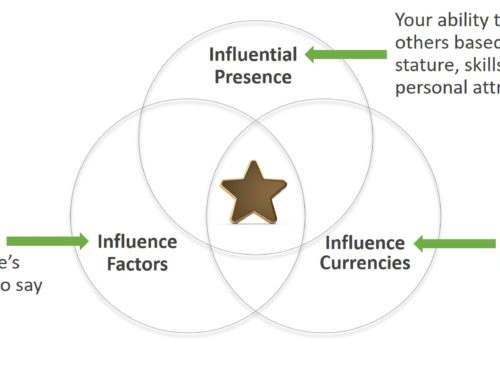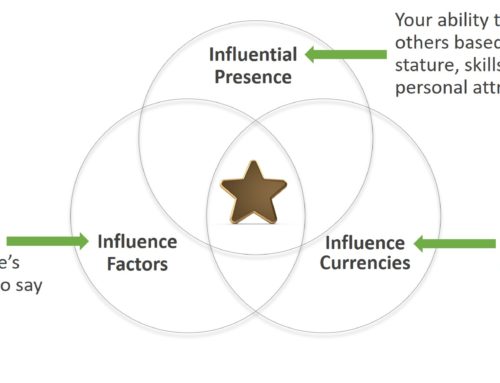One of my favorite ways to influence others is to perform a task that needs to be done anyway and to do it a manner that causes the other person to react in a specific way.
For example, if a Project Manager needs a project stakeholder to respond to emails more quickly, The Project Manger should respond to their emails quickly with the hope that they will return the favor.
I worked with a an IT executive who took two or three days to respond to my emails. This was problematic because I was under a tight deadline and could not move forward without the executive’s input on certain aspects of the project. In an attempt to speed up his replies, I would answer his messages within five or ten minutes. Because I always replied to his email messages right away, over time, he felt guilty that he did not do the same for me. As a result of this guilt, he began to return my email messages as soon as they arrived. Truth be told, this story falls under the category of: If you can’t be smart, be lucky. Initially, I started responding to his emails so quickly because I thought he would email back right away if I could catch him while he was still working on email. It wasn’t until weeks later that he realized his change was an influence-based reaction to my action. I got the result I wanted, but not for the reason I expected. I had no idea I was making him feel guilty about his slow replies. I thought he was simply still in the process of returning emails. Live and learn.
This is an example of the action/reaction influence concept. It does not always work, but over time, I’ve found it has a high winning percentage.
The beauty of this concept is that I had to write the email anyway, so all I did was strategically change the timing. Like this example, virtually all the techniques discussed in this blog take very little or no additional effort, just strategic intent.
Additional action/reaction tactics are listed below.
1. Starting Meetings on Time
Starting your meetings on time, even if all participants are not present, has many non-influence benefits, including:
- Allowing more time to get things done (a full sixty minutes for a one-hour meeting).
- Providing the opportunity to end the meeting early, giving participants a few minutes of the day back or to get to their next meeting.
- Illustrating your personal timeliness.
- Showing your respect for the people who show up on time.
From an influence perspective, your action of starting the meeting on time causes the following reactions:
- Influences people to be on time for your meetings because they feel uncomfortable joining a meeting after it has already begun.
- Influences people to complete their deliverables/tasks on time because you have a reputation for being timely.
- Assures willingness to attend your meetings because people know the meeting will start on time and possibly end early.
2. Accepting Constructive Feedback
Your willingness to solicit and accept feedback from others has many business advantages, including:
- Gaining insight into how others judge your work.
- Gaining deeper understanding of your clients’ current and future needs.
- Showing your strength of character by illustrating your willingness to listen to others.
- Illustrating your responsiveness in correcting issues and/or taking advantage of previously unseen business opportunities.
From an influence perspective, your action of soliciting and accepting constructive feedback, and exhibiting your willingness to correct your shortcomings, also causes the reaction of making other people, including your staff, more willing to accept constructive feedback from you.
When I was a software developer in IT working on user interface related screens, after the software was deployed, I would seek out people who where using the software. I would ask them what they didn’t like about the application. They would look at me funny and say, “Don’t you mean what I like about the application?” I would tell them “Sure, tell me what you like about it, but I’m most interested to learn what you don’t like, so I can make it better for you.”
Four wonderful things continued to happen because of conversations like these.
- First, they provided me with great input on how to improve the applications I had written, which were quickly implemented.
- Second, they had a very positive effect on user satisfaction because they appreciated being asked and they liked they enhanced user interface that was created based on their conversations.
- Third, this feedback loop was of great value to me professionally because it helped me learn to design better user interfaces.
- Forth, it enhanced my reputation within the user community, thus enhancing my personal influence and professional brand.
3. Overcommunicating
If you have staff, stakeholders, vendors, senior managers, or others who do not provide you with the information and/or communication you need to get your job done, the action of overcommunicating with them to provide the data they need causes the reaction of making them feel guilty for not communicating their information to you. These feelings will, hopefully, cause them to be more communicative.
4. Providing Deliverables Early
Business advantages exist for completing and providing your deliverables a little early, including:
- Being seen as a dependable business partner.
- Reducing personal stress related to last minute sprints to complete assignments.
- Illustrating your time-management capabilities and organizational skills.
- Reducing stress and uncertainty for those who cannot accomplish their work until they receive your deliverables.
From an influence perspective, your action of completing your tasks early causes the following reactions:
- More business leaders and peers want to work with you.
- Your consistently early completion of deliverables, especially those that pass back-and-forth with another party, helps push others to get their work done on time.
The reaming action/reaction influence techniques will be discussed in my next blog!




